741 FOX TERRIER
IN PRAISE OF THE FOX TERRIER
by David Hancock
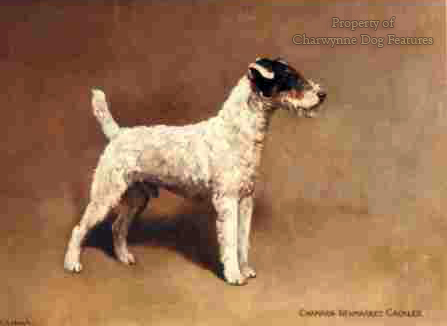
"That the fox terrier of today is a great improvement, in so far as looks go, on his predecessors of forty or fifty years ago is beyond question, though whether he is better suited physically or morally for work underground is a matter of opinion". - Pierce O'Conor, "Sporting Terriers", 1926.
In an article in Countryman’s Weekly in 2004, Jeremy Hobson was writing: “Why does the Fox Terrier have a greater following in France than in its country of origin?” He had been visiting the great French game fair or Fete de la Chasse in the Loire valley, watching the fine parade of clubs devoted to ‘la venerie sous terre’, showing off their earthdogs, mainly old-fashioned type wire and smooth Fox Terriers, but ones with deep chests, powerful shoulders and waterproof coats. Such packs were prized by British sportsmen from Kenya to the garrisons of India. It would be educational for show ring breeders of Fox Terriers to attend such a fair and see the crucial difference between their rosette-winning specimens and the much more functional terriers so highly rated by experienced French hunters. Our pedigree Fox Terriers do seem to be valued more for their silhouette than their skill as a terrier.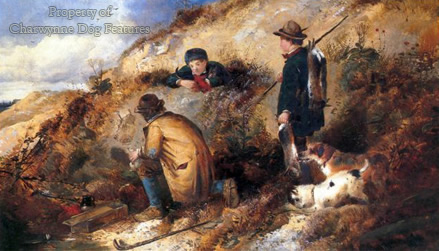
When I was a boy Fox Terriers were everywhere, especially at harvest time. Once the first choice of some hunts as hunt terriers, they became a favourite companion dog, yet, unlike say the Cocker Spaniel, gradually faded from the scene. In some ways they reflect the changes in our society: a preference for exotic dogs and exotic holidays, a desire for flashier canines and cars and a failure to acknowledge the merits of home-grown products, whether they are from dog-breeders, dairies or dockyards. In 1910, the Kennel Club registered over 1,500 smooth Fox Terriers and over 1,300 wire-haired Fox Terriers, against nearly 700 Cockers. Seventeen years later, over 10,000 Fox Terriers of both coats were registered against well over 4,000 Cockers; both breeds had arrived.
In 2009, over 22,000 Cockers were registered with the KC, against just 133 smooth and 604 wire-haired Fox Terriers. The Cockers had arrived and stayed, the Fox Terrier as a breed is under threat. For such an honest, companionable and fussless breed to falter is a pity, for their working use to all but disappear is simply tragic. Fox Terriers were first listed as a distinct type in 1862 and both wires and smooths were interbred for many years after their show ring debut. By 1890, however, some clearly defined bloodlines began to predominate in each coated variety. Names such as Ch Barkley Ben and Ch Meersbrook Bristles appear at the beginning of all Wire Fox Terrier pedigrees. This breed was founded upon several strains that were derived from packs of Fox Hounds’ hunt terriers with the main sources being dogs like Old Jock, Old Trap, Old Foiler, Old Buffer and Belvoir Joe, who had perhaps the greatest influence on the modern breed. The latter’s son Belgrave Joe is found way back in most pedigrees. Old Trap was sired by a black and tan dog; Old Foiler’s dam, Judy, came from the Rev John Russell’s strain.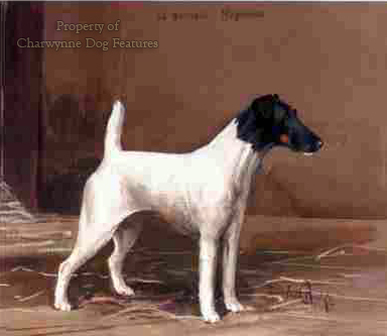
In his British Dogs of 1903, Drury writes: “I think few will differ from me when I say that the Grove and Belvoir have taken more pride in their breed of Terriers than any other pack, and have crossed them as carefully as they did their Hounds.” That is some praise. The Belvoir preferred the ‘old black and tan’ sort, getting stock from a noted breeder William Singleton of Grantham, who, Drury states, ‘kept them free from Bull for over forty years’. The Belvoir pack has long been famous for its tricolour or parti-coloured hounds. There is an inference here too that regular infusions of bull-and-terrier blood were practised by working terrier breeders. Drury also observes that “However, even to the present day, or at least till very recently, the Duke of Beaufort has kept up a breed of black-and-tan Fox-terriers, and excellent dogs they are too”. Most Fox Terriers nowadays in both coated varieties appear to be mainly white and favoured as such. 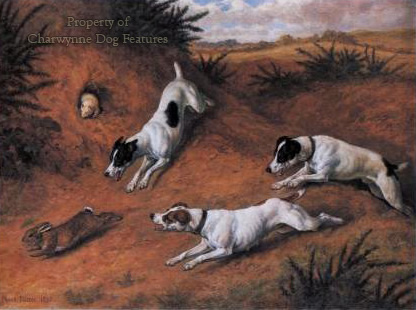
I wonder how wise it was to seek separate recognition for terriers carrying a different coat but coming from the same root stock. Recognition of more than one breed from the same root really does make a difference. Once the different breeds have become established with their separate stud-books, each gene-pool becomes sealed and genetic isolation results. This is artificial and not how nature works. But just as crucial is the work of fanciers who develop breed points to the degree where the two breeds, from the same origin, are bred and judged differently. I would question the wisdom of this. Some breeds bearing the same basic breed name but featuring different coat textures have developed from separate roots. The German Pointers demonstrate this and I can understand separate breed status for the Wire-haired and Long-Haired from the Short-haired breed. This is not the case in the Fox Terrier. One MFH is on record as stating that “As all terrier-men know, a good way to get a real, hard, wiry, weather-resisting coat is to cross a wire with a smooth.” 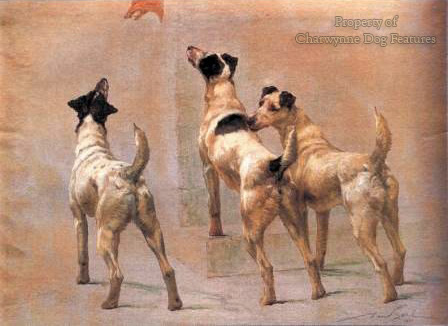
In his Modern Dogs (Terriers) of 1896, Rawdon Lee writes on the Fox Terrier: "...the two varieties ought to be identical, though one has a smooth, close coat, the other a hard close coat and somewhat rough." In his The Popular Fox Terrier of 1950, Rosslyn Bruce writes: "The two varieties, the Smooth-coated and Wire-haired, are fundamentally the same breed..." Both these writers were experts on the breed and worthy of note. Both record in detail a common origin for what is now two distinct breeds. So many pedigree dog breeders are obsessed with breed purity when they should, if they truly care about their breed, be obsessed with sound functional dogs.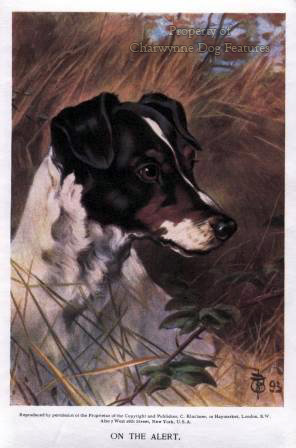
Major Harding Cox, a leading figure in the canine world of this time, wrote, in his Dogs and I of 1928, “For the manufacture of a smooth Fox-terrier the following recipe is to be commended. Take an old-fashioned ratting terrier and mate it with a White English Terrier of quality, cross the produce with a small-sized Bull-terrier, and then, in succeeding generations, breed to eliminate the Bulldog characteristics as introduced by the said Bull-terrier.” He ridiculed the whole concept of breeding leggy terriers capable of running with the hounds, writing that “The theory anent (i.e.concerning, DH) Fox-terriers running with Fox-hounds is a fatuous one.” He considered that such misguided thinking resulted in long-legged badly-constructed terriers no longer capable of being earth-dogs. It is significant to note the type of sporting terriers which have survived the quest for terriers which can ‘follow the hunt’.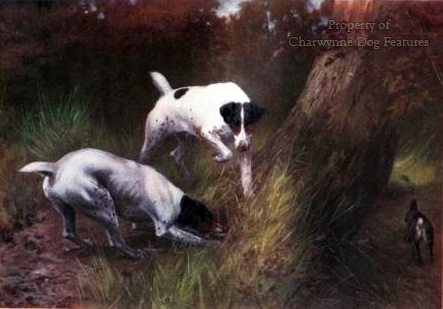
Harding Cox was also responsible for the famous letter to The Field magazine of April 1897, in which he expressed equally strong views about terrier construction: “In the early seventies there was a reaction against the cloddy or cob-built Terrier – the ‘brick with the four corners knocked off’, as it was facetiously called…We now have dogs so narrow in front, so oblique in shoulder, that as a natural result they have flat sides, weak back ribs, long couplings, wedge-like and feeble quarters, with enough daylight under them to absorb a Norwegian summer. This is not the first time I have fallen foul of those misguided enthusiasts whose ambition it is to breed Terriers to live with hounds. I have no hesitation in positively stating that no Fox-terrier that ever was bred could live with any decent pack of Foxhounds when really carrying a head…I claim that for purposes of going to ground, and staying there as long as required, I would back a well-balanced, sturdy Terrier with good chest and ribs against any of the leggy, narrow, and ‘spiry’ dogs of the show-bench today.” TM Fogg, writing in Compton’s The Twentieth Century Dog of 1904, gave the view: 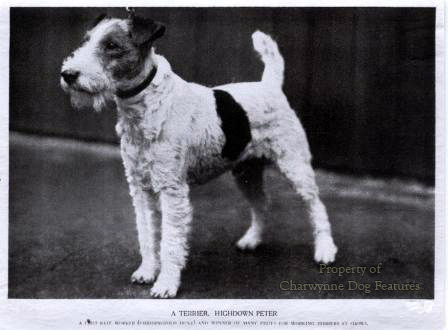
“In my opinion the present-day dog is much too large, and losing all terrier character; and, as a rule, the wires are very weak in their hindquarters, which is one of the most essential points of the working terrier…The type that some judges favour is totally at variance with the working terrier…To my mind there are not so many genuine, good, all-round terriers at the present time as there were fifteen years ago, when I started breeding. I consider the reason for this is that there are to many crazes, such as getting absurdly long, narrow heads and fronts to suit the present-day judge.”
This is a breed I admire (and for me it is one breed). I have visited their rings at shows over fifty years and rarely been pleased with the entry. Upright shoulders, open coats in the wires, snipey muzzles and too short a back seem to be acceptable features. The breed standard however demands sloping shoulders, well laid back and, in the wires, a dense very wiry coat. Both are required to have short backs without the degree of brevity being stipulated. This is no feature for an earthdog breed; cobbiness may look smart 'on the flags' but it's a considerable handicap underground. It is all too easy for show breeders to forget where their breed came from. Lady Edith Villiers, writing in Compton’s The Twentieth Century Dog of 1904 stated: “ It is often said that the show fox terrier is no workman. This is of course the case when they are not entered. So many terriers hardly leave their kennels except for the show bench, and are not able to look out for themselves like those running about all day. One of my prize terriers…was very game; she ran all last season with the Pytchley, and bolted many foxes.”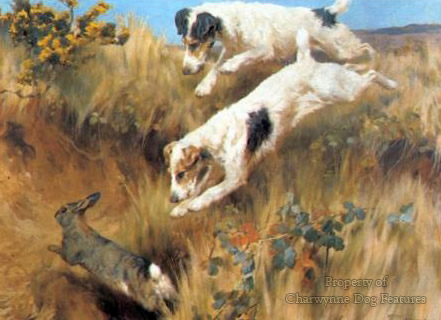
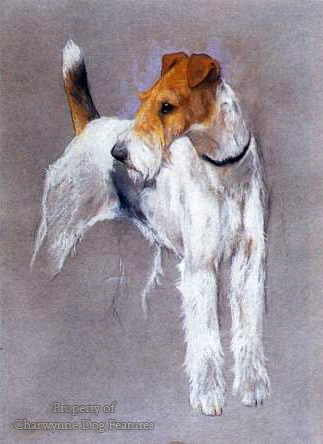
Rosslyn Bruce objects to the craze for elongated muzzles and the obliterated 'stop' which accompanies this feature. Most of the show Fox Terriers I see have over-long heads and hardly any 'stop' at all. He also wrote that: "An erroneous impression is prevalent that a Fox Terrier must be squarely built, and that by standing the Terrier sideways on, if of the ideal build and shape, he should fit into all the sides of a square." He then makes a convincing argument against too square a dog. Yet, time and time again, down the years, I have seen square Fox Terriers win prizes at prestigious shows. Perhaps, as in so many breeds, the dogs are being bred to win prizes and not to improve the breed. To be fair to today's breeders many of the faults I see are hardly new.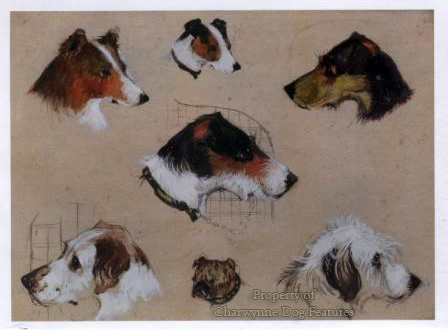
In The Kennel Gazette of 1884, there is a critique which reads: "Diadem, the once-sensational, and the only remaining entry in the class, being third. She is far too short in body for my taste, has upright shoulders, and is not enough of a working terrier." For a Smooth-haired Fox terrier to come third and be 'once-sensational' with these shortcomings is depressing. In a critique of 1933, Major Hayward, reporting on a Wire-haired entry, wrote: "With few exceptions looseness at elbows, weak fronts and bad feet and unsoundness prevailed, while hocks were too far away from the body." He would not have liked the contemporary fetish for the hocks to be too far away from the body in far too many 'flashy' breeds. In the 1950s, Colonel Phipps was writing on the entry of the same breed: "I only hope for the sake of the breed that it was not a representative one as otherwise the outlook is not good...I am still of the opinion that breeders are losing or have lost sight of the fact that a Fox-terrier is primarily a working dog." Time and time again, show fanciers admire a breed so much that they can't wait to move it away from its original blueprint and a word picture related to the function which shaped the breed.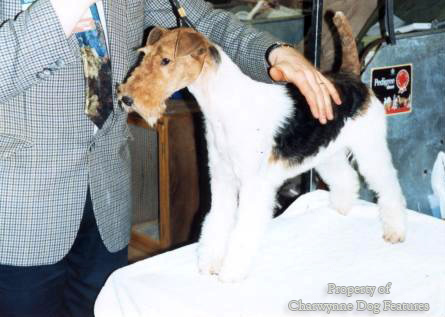
Writing half a century ago, in his The Domestic Dog, Brian Vesey-Fitzgerald wrote, when discussing the impact of fashion on the show ring dogs: “It would be true to say that no show champion of twenty years ago – certainly in the terriers, and in most other breeds as well – would stand a chance today. In the terriers, at least, their heads would be described as ‘coarse’; and none of the old champions, so highly regarded so short a while ago, would, of course, be ‘standing up on his toes on stiff and useless pasterns.” Fifty years later we see the same faults in show terriers, faults which are now inbred and accepted by conformation judges in KC show rings as not just acceptable but typical, and therefore somehow desirable. What has been termed ‘Fox Terrier thinking’, developed at the end of the 19th century, especially over front assemblies in terriers has had far-reaching and long-lasting influences in far too many pedigree terrier breeds.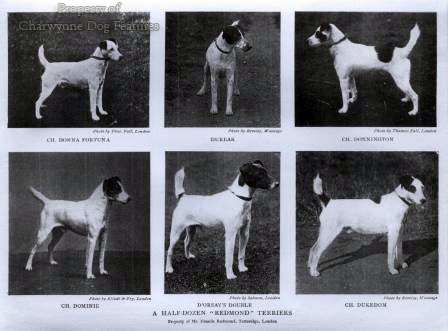
Working terrier breeders understand why certain anatomical features are important; without wishing to sound too cynical, far too many show breeders rate physical features solely by their ability to appeal to a judge. Functional terriers need a front assembly that supports their work and contributes to their success. Working dogs do not deserve the handicap of an unsuitable coat. In the last few years I have judged terriers, from unregistered terrier breeds, at their annual breed club shows and found really good shoulders and hard, crisp, weatherproof coats in the coated varieties. These were bred by men who used their dogs in the field but these were not KC registered breeds. The Fox Terrier is very much part of the sporting heritage of England; it would be good to see them favoured by terrier-men once again, just as the Rufford and Grove packs did over a century ago.
“The majority of even our best dogs are too big and leggy, and many are weak in hindquarters. The desire to obtain long-headed dogs, and the exaggerated importance so many judges appear to attach to the heads would seem to be responsible for this state of things. Coats also require more attention; a short, hard, close jacket is what is wanted. The keen, restless, dare-devil expression of a true terrier is too seldom seen.”
Capt CJ Wilkie, writing in Compton’s The Twentieth Century Dog of 1904.